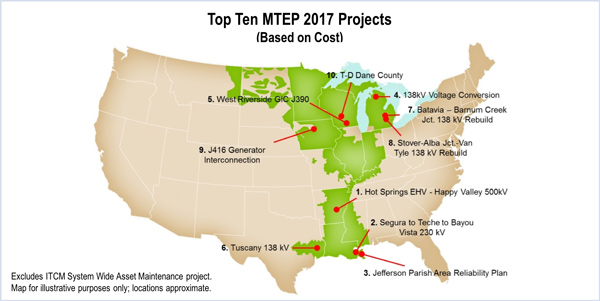By Amanda Durish Cook
ST. PAUL, Minn. — MISO plans to recommend that its Board of Directors approve 343 new projects estimated at $2.6 billion as part of the RTO’s annual transmission plan.
This year’s draft project round-up comes in 40 projects short of MTEP 16 but costs about the same, directors and stakeholders learned at a Sept. 19 meeting of the board’s System Planning Committee.
MISO Vice President of System Planning Jennifer Curran said the top 10 priciest projects in MTEP 17, ranging from $26 million to $149 million, are spread “fairly evenly” across the footprint, with three in Michigan, two each in Louisiana and Wisconsin, and one each in Iowa, Arkansas and eastern Texas.
While the RTO included only half of those projects for baseline reliability reasons, the Iowa and Wisconsin projects both originated from generator interconnection requests, showing that interconnections are increasingly becoming major transmission projects themselves, Curran said. MTEP 17’s most expensive project, a new $149 million 500-kV line from Hot Springs to Happy Valley in Arkansas, is meant to relieve reoccurring thermal overloads.
Curran said just one MTEP 17 contender may qualify as a market efficiency project. The $129.7 million project involves construction of a new substation in eastern Texas equipped with a 500/230-kV transformer. The facility would accommodate a new 500-kV line running from Hartburg, Texas, as well as a reconfiguration of the existing Sabine-McFadden and Sabine-Nederland 230-kV lines to fully relieve area congestion and reduce the amount of voltage and local reliability make-whole payments needed in the West of the Atchafalaya Basin load pocket. Some MISO stakeholders this month complained about what they perceived as late-stage modeling changes to the project. (See Late Changes to Texas Project Frustrate MISO Participants.)
Curran said the project will undergo additional stakeholder review before coming back for board approval in early December.
No Tx Coming for North-South Constraint
MISO’s collection of MTEP 17 studies this year included a footprint diversity study, an extra analysis specifically designed to identify viable transmission projects to connect the RTO’s Midwest region with MISO South. However, Curran said not one of the study’s 35 potential projects could pass the 1.25-to-1 benefit-cost criteria based on adjusted production cost benefits.
“The physical congestion, while it exists, isn’t enough to justify a fairly expensive transmission project. I think there are other benefits that aren’t being considered, but that’s the nature of this process,” Curran said.
Curran said that over the course of the study, MISO “learned a lot about the nature of the flows” near the North-South transfer constraint.





